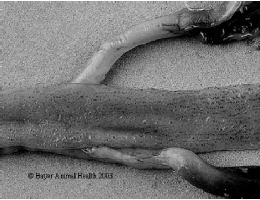ThePoultrySite Quick Disease Guide
Contents of Quick Disease Guide
Coccidiosis, Ileorectal, E brunetti
|
Extracted From:
A Pocket Guide to
Poultry Health and Disease 
|
Introduction
A relatively rare form of coccidiosis affecting chickens worldwide caused by Eimeria brunetti. Of moderate to high pathogenicity, it is found in the terminal ileum, caecum and rectum. Morbidity and mortality are variable.
Signs
- Depression.
- Ruffled feathers.
- Closed eyes.
- Inappetance.
- Poor production.
- Diarrhoea, blood in faeces.
Post-mortem lesions
- Petechiae and thickening of the distal third or more of intestine, extending into caecal tonsils.
- Severe necrotising enteritis.
- Oocysts in caecum and rectum.
Diagnosis
Signs, lesions, microscopic examination of scrapings. Differentiate from ulcerative enteritis, caecal coccidiosis.
Treatment
Toltrazuril, Sulphonamides, Amprolium, Vitamins A and K in feed or water.
Prevention
Coccidiostats in feed, vaccination by controlled exposure, hygiene. This species is not usually included in vaccines for broilers. There is good immunity to the same parasite in recovered birds.
 |
| Figure 16. Moderate Eimeria brunetti infection in the terminal ileum and rectum of a chicken. There is thickening of the intestinal mucosa and there are lines of haemorrhagic spots in the mucosa. |


 © 2000 - 2021. Global Ag MediaNinguna parte de este sitio puede ser reproducida sin previa autorización.
© 2000 - 2021. Global Ag MediaNinguna parte de este sitio puede ser reproducida sin previa autorización.